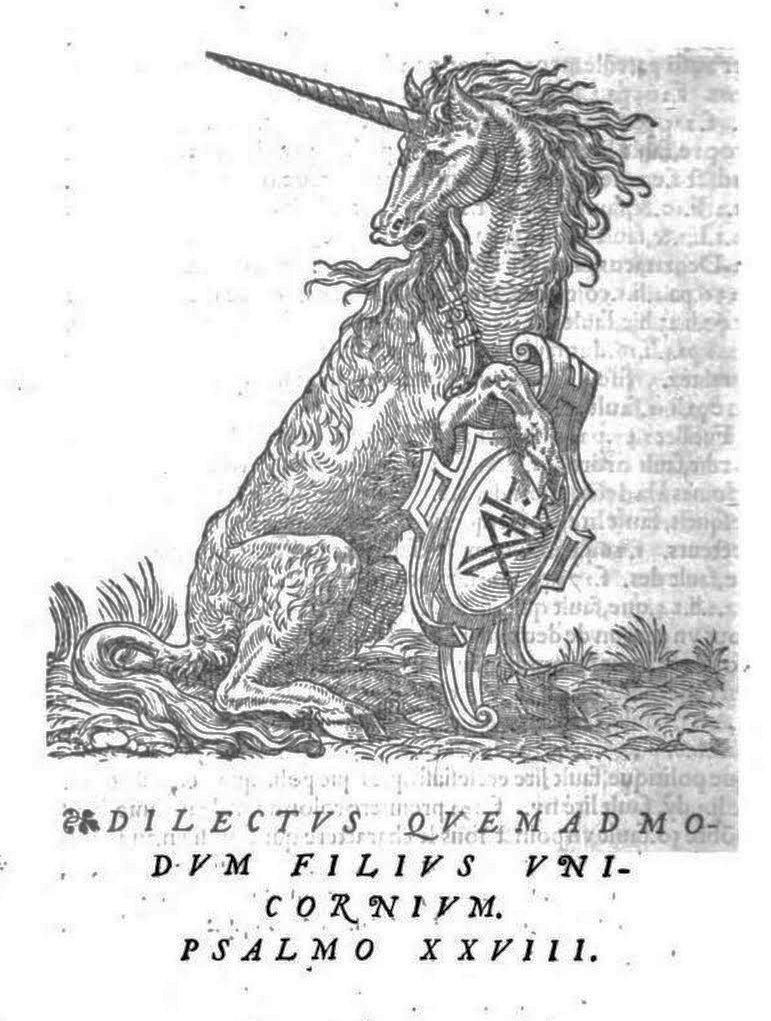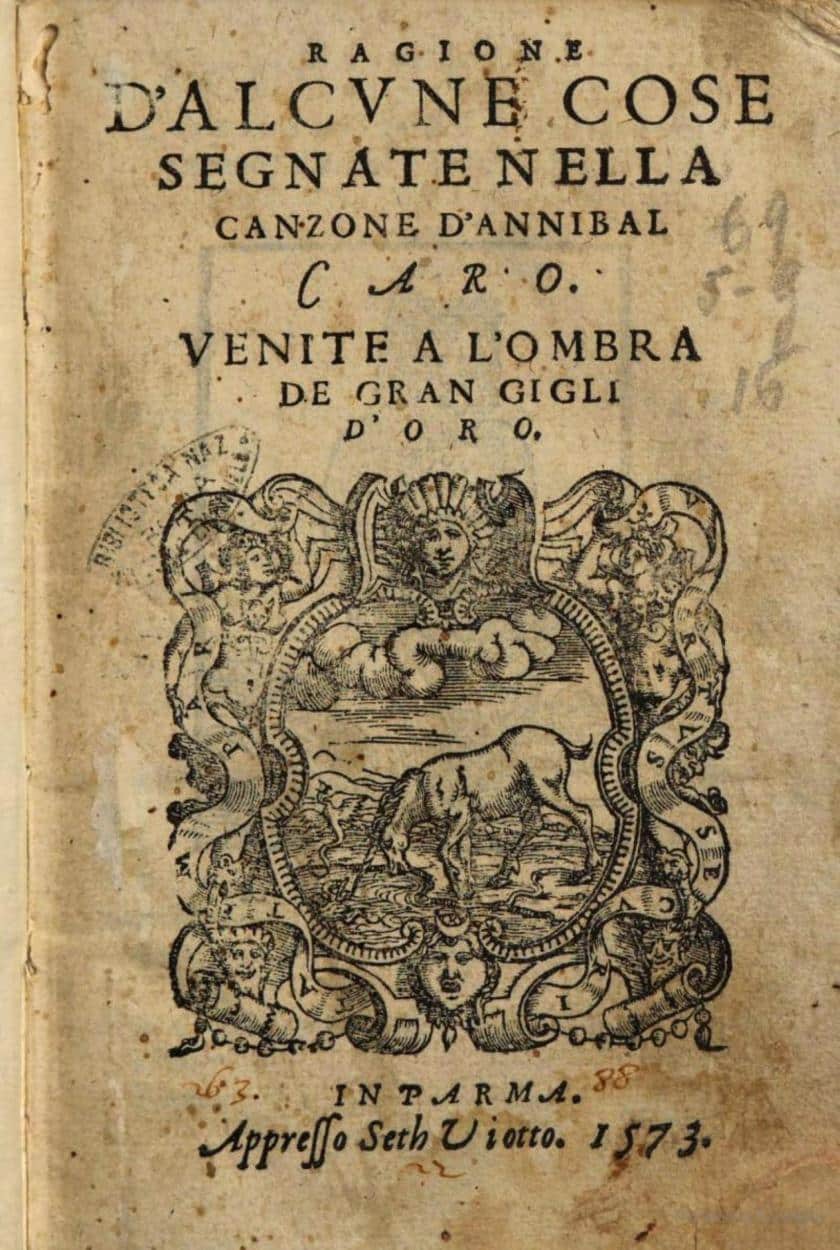
Last page of ברית אברהם (“Abraham’s Covenant”), by Abraham Shabbetai ha-Levi Horowitz. Printed by Kalonymus ben Mordechai Jaffe and his son Hayyim bar Kalonymus in Lublin, 1577. Hebraic Section of the African and Middle Eastern Division.
The unicorn in this image comes just after the colophon on the final page of ברית אברהם (“Abraham’s Covenant,” a Hebrew essay on repentance written by Abraham Shabbetai ha-Levi Horowitz, a respected Jewish author and scholar from the first half of the 16th century, and printed in Lublin in 1577 by Kalonymus ben Mordechai Jaffe, a prolific printer who came to Lublin possibly from Prague, and who ultimately printed some 37 different titles. Here is the colophon in translation:
Finit the Covenant of Abraham
Today is Monday, the 26th of the month of Shevat in the year 1577.
The holy craft was established by Kalonymus ben Mordechai Jaffe the Printer
and his son Hayyim bar Kalonymus the Printer
The second unicorn (clearly its identical twin) comes in another book printed by Kalonymus also in 1577, and again on the final page of the book just after the colophon. This book is Hesed Avraham (“Abraham’s Loving Kindness”), a commentary on Maimonides’ Eight Chapters by the same scholar who wrote “Abraham’s Covenant.”
Like the unicorns in the printer’s marks of quite a few European-language books, our two Hebrew unicorns are seen propping up some kind of shield or heraldic device.
From the colophon of Polygraphie, et Universelle Escriture Cabalistique de M.I. Tritheme Abbe. Paris: Jacques Kerver, 1561. Rare Book and Collections Division, Library of Congress.
The image on the shield in our Hebrew book, “Abraham’s Covenant,” appears to be two diagonally-placed mallets, or hammers, with three stars in between. While we cannot identify the source of this image, it is highly reminiscent of coats-of-arms employed by several localities across Europe. One could point to at least half a dozen in Bohemia alone (e.g., the town of Dobríc). Assuming the shield has a geographic significance, this part of the image makes sense in the context of a printer’s mark. But what about the unicorn? Clearly they were created together – shield and unicorn in one woodblock form.
Little noticed in the research, the unicorn printer’s mark adopted by Kalonymus and partners raises a host of interesting questions.(i) Is it original or borrowed? Decorative in purpose or replete with significance? Printer’s marks could be any of these in the early years of printing, so in order to answer these questions let us first take a closer look at the history of the unicorn and its meaning in the medieval world.
The unicorn has a long and varied career in the annals of world literature, with writers and artists all presenting competing visions of the fabulous creature. But by the mid-fifteenth century and the dawn of the printing press, the years had distilled the various traditions and myths into the unicorn we know today: an equine creature that is white in color, and with a single horn capable of purifying poisoned waters. Fierce and independent, or so the legend continues, the unicorn can only be captured by means of a virgin, to whom it kneels in willing submission.
Title-page from Ragione d’alcune cose segnate nella Canzone d’Annibal Caro (The reason why certain things are highlighted in the song of Annibal Caro) by Lodovico Castelvetro. Parma, 1573.
A unicorn in the lap of a virgin. Woodcut illustration from Hortus sanitatis, London, 1521. Rare Book and Collections Division, Library of Congress.
The unicorn also emerged in the Middle Ages as a potent symbol of Christianity; the embodiment of purity and the divine plan of redemption. No wonder, then, that the unicorn figures so prominently in European heraldry as the emblem of knightly virtue or that it graces so many books printed in 16th- and 17th-century Europe.
A symbol of Christianity and the emblem of knightly virtue – what could any of this have to do with religious books in Hebrew? By the same token, one also wonders whether the image was created especially for this Lublin print shop or, as seems more likely, borrowed from some non-Hebraic tome making the rounds of sixteenth-century Europe. Images and borders tended to migrate during the early years of printing, not only from one printer to another but from country to country and from language to language. Yet even if the unicorn was borrowed from some other source, the question remains the same. After all, our unicorns did not just stray into these Hebrew books by accident, in search of forage or virgin maidens. They were put there by choice. What, then, made Kalonymus ben Mordechai and his partners choose a unicorn for their printer’s mark?
In a more general sense, this is the question scholars have long been asking about other symbols – pagan, Christian, Islamic – found in Jewish Art through the ages. One thinks, for example, of the zodiac signs decorating ancient synagogue floors throughout the lands of Byzantium, complete with a mosaic of the sun god Helios and his chariot. Long considered merely “decorative” in function or signs of assimilation to the local environment, scholars of Jewish art now tend to find these symbols richer in meaning than formerly believed and rooted in ancient Jewish sources. So, for example, Helios could also be contextualized within the Bible itself thanks to verses from Psalms and elsewhere associating Yahweh with chariots, the sun, and flames of fire. Thus the outer symbol, ostensibly pagan in nature, would be made harmonious with the deepest beliefs and traditions of Judaism.
Unicorns provide another good example. Art Historian Marc Michael Epstein, for example, has made a case for interpreting the unicorns found in the margins of Hebrew manuscripts and elsewhere as symbols of Jewish redemption and messianic hopes. Basing this characterization on a swirl of ancient Jewish legends, Epstein calls these unicorns “a subversive symbol of Jewish pride and resistance.”(ii) In choosing a unicorn for their printer’s mark, therefore, our printers were only picking up the signals of their times and them translating them into their own, ultimately Jewish terms.
But even if we accept this answer to the question “why a unicorn?” there is still a problem. Epstein notes that in Jewish Art, the unicorn is always “swift, free . . . impossible to capture.” Only, that is clearly not the case here.
The unicorn in our Hebrew printer’s mark is recumbent and docile, its hooves neatly tucked under, its eyes cast down and modest. Not the “swift, free” creature usual to Jewish art, according to Epstein. Perhaps in selecting a unicorn representing submission rather than defiance, our printers were emphasizing the role of repentance in hastening the Messianic Age. In the final sentences just before the colophon in “Abraham’s Covenant,” for example, the author expresses the hope that he and “all his seed fulfill God’s laws, serve Him with a perfect heart and ponder His teachings before the Messianic Age.” Here, then, as in much of Jewish thought, redemption is envisioned not only as the coming of the Messiah but as a spiritual process for which man must take responsibility. And with this in mind, our unicorn begins to interact with the text, leaving the realm of “merely” decorative beauty for the world of ideas and beliefs. If the unicorn is a symbol of strength – wild, free and independent before its capture by the virgin maiden – perhaps in these religious Hebrew books the unicorn is transformed into a symbol of human nature – strong, wild, and unruly before it is tamed by purity and submission to God. Hence a recumbent unicorn, mirroring a soul made submissive to goodness and divine law. Still a symbol of Jewish redemption and messianic hopes, as suggested by Epstein, but one that represents the role of individual men and women in bringing it about.
While this attempt to unravel meaning from the unicorn may seem invalid to some readers, it is worth remembering that we live in an age that is far removed from the symbols and codes that fed the undercurrent of life in 16th-century Europe. Justyna Kilianczyk-Zieba, a noted scholar of Polish book history, has shown the rich interplay between images and emblems during the second half of the 16th century, in Poland as in the rest of Europe. Printers, as Kilianczyk-Zieba concludes, developed these images to create identities for themselves “not only as businessmen but as humanists and intellectuals.”(iii) And against this artistic and intellectual background, both our printer and our unicorn spring richly to life, demanding our attention – and our questions.
Notes:
(i) Yitzhak Yudlov. “Digle Madpisim.” Jerusalem, 2002, p. 32.
(ii) Marc Michael Epstein. “Dreams of Subversion in Medieval Jewish Art and Literature.” University Park: University of Pennsylvania Press, 1997, pp. 104-109.
(iii) Justyna Kilianczyk-Zieba, “The Transition of the Printer’s Device from a Sign of Identification to a Symbol of Aspirations and Beliefs,” in: Typographorum Emblemata: The Printer’s Mark in the Context of Early Modern Culture,” pp. 315-331. Edited by Anja Wolkenhauer and Bernhard F. Scholz. Berlin – Boston: Walter de Gruyter, 2018.



